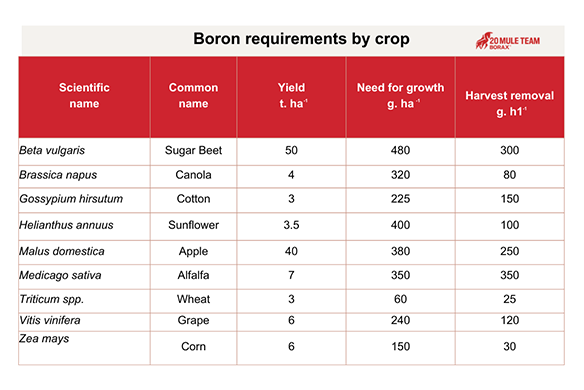Boron (B) is an essential micronutrient for all plant species. In agriculture, boron is one of the most deficient minerals in soil around the world.
Different crops, different boron needs
We all know that different crops have different nutrient requirements. The same is true for boron. Requirements range from 60 to 480 g/ha.* As a rule, boron is an immobile nutrient in the phloem tissue of plants. There are exceptions, specifically in plants that produce polyols as sorbitol, mannitol, and dulcitol. The polyols work to make boron mobile in the phloem.
Boron’s function
Plants require boron to maintain cell wall structure and encourage cell expansion. It’s also important for cell membrane stability. Boron deficiency disrupts reproductive growth, shoot and root growth, and pollen viability. This, in turn, influences seed set and yield. Boron deficiency can result in deformed leaves and poor-quality harvests—in both yield quantity and product quality.
General crop guidelines
Boron concentration is different among species. For example, dicots require higher levels of boron than monocots. In the formation of cell membrane pectin, boron is involved in absorption and metabolism of cations, especially calcium (Ca). Boron and calcium are strongly linked to the formation of cell walls. Dicot species have greater calcium in their composition, naturally requiring more boron as well.

Source: Shorrocks, VM. 1997. The occurrence and correction of boron deficiency. Plant and Soil. 193: 121-148.

Source: Shorrocks, VM. 1997. The occurrence and correction of boron deficiency. Plant and Soil. 193: 121-148.
Have more questions?
Our regional agronomists and sales managers have extensive knowledge of boron requirements for crops in your area. Contact us for specific U.S. Borax product recommendations.
*Always consult with your local agronomist for specific boron dosage.
Resources